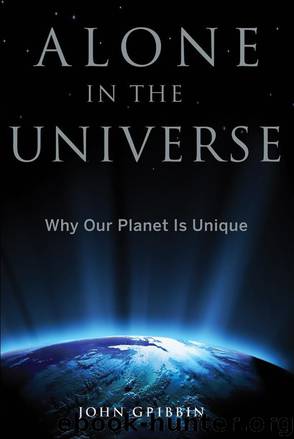Alone in the Universe: Why Our Planet Is Unique by John Gribbin

Author:John Gribbin [Gribbin, John]
Language: eng
Format: epub
Tags: Science / Physics
ISBN: 9781118147979
Google: h62NZwEACAAJ
Amazon: B00DNL378A
Publisher: Wiley
Published: 2011-11-02T07:00:00+00:00
MAKING PLANETS
Armed with this understanding of the geography of the Solar System, we can begin to understand how the planets formed, and why the Solar System is special. Working back inwards from the Oort Cloud, the key to this understanding is the way the giant planets formed, and the role of Jupiter in particular.
The giant planets cannot have been formed simply by sticking smaller pieces of material together to build up gas (or ice) giants. A lump of rock with several times the mass of the Earth, in the orbit of Jupiter or beyond, could indeed attract gas from a cloud like the one in which the Sun formed and build up to the size of the giants – but it would take longer than the present age of the Solar System to make planets like Uranus and Neptune this way in their present orbits, because there was little gas available that far from the Sun. The only alternative is that all four of the giant planets formed closer to the Sun than Saturn is today, but farther out than the present orbit of Jupiter, where there was plenty of gas but it was also cold enough for icy material to exist. They would have formed close to one another, in a cloud of gas swarming with planetisimals made of ice and rock. It was just by chance that four giants emerged from the mêlée. Although inevitably one of the four had to be bigger than the others and came to dominate the orbital dynamics of the system through its gravitational influence, there was nothing inevitable about the way that Jupiter became so much bigger than the other planets put together; it is just one more of those things that distinguishes our Solar System from other planetary systems.
Computer simulations show that in these circumstances the orbit of the largest planet (Jupiter) moves slowly inwards towards the Sun, while the orbits of the three smaller planets (Saturn, Uranus, Neptune) move slowly outwards, conserving angular momentum. At first, this process proceeds smoothly. But about 700 million years after the Solar System formed, it passes through a so-called resonance, a situation in which Saturn takes exactly twice as long to orbit the Sun as Jupiter. In this situation the combined influence of Saturn and Jupiter produces a powerful, rhythmic influence on the smaller planets in the outer Solar System. The simulations tell us that as a result Uranus and Neptune both suddenly moved farther out from the Sun, with the orbit of Neptune doubling in size and sending the planet into the inner region of what was then a much larger Kuiper Belt. These disturbances shook up the smaller objects in the outer Solar System, sending many of them falling in towards the Sun, where a large number smashed into the inner planets, many outwards into the depths of space, and some close to the giants where they were captured and became moons. It was only after this interval of turmoil that the
Download
This site does not store any files on its server. We only index and link to content provided by other sites. Please contact the content providers to delete copyright contents if any and email us, we'll remove relevant links or contents immediately.
Tools of Titans by Timothy Ferriss(8186)
Turbulence by E. J. Noyes(7920)
Secrets of Antigravity Propulsion: Tesla, UFOs, and Classified Aerospace Technology by Ph.D. Paul A. Laviolette(5299)
Astrophysics for People in a Hurry by Neil DeGrasse Tyson(5120)
Room 212 by Kate Stewart(5014)
Design of Trajectory Optimization Approach for Space Maneuver Vehicle Skip Entry Problems by Runqi Chai & Al Savvaris & Antonios Tsourdos & Senchun Chai(4996)
Pale Blue Dot by Carl Sagan(4886)
The David Icke Guide to the Global Conspiracy (and how to end it) by David Icke(4606)
A Journey Through Divination and Astronomy by Publishing Pottermore(4332)
Goodbye Paradise(3714)
Apollo 8 by Jeffrey Kluger(3621)
COSMOS by Carl Sagan(3539)
Losing the Nobel Prize by Brian Keating(3489)
The Five People You Meet in Heaven by Mitch Albom(3460)
How to Read Water: Clues and Patterns from Puddles to the Sea (Natural Navigation) by Tristan Gooley(3386)
Brief Answers to the Big Questions by Stephen Hawking(3357)
How to Read Nature by Tristan Gooley(3231)
The Order of Time by Carlo Rovelli(3131)
A Brief History of Time by Stephen Hawking(2946)
